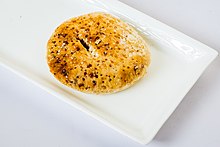Bakarkhani
 Bakarkhani being made in Dhaka, Bangladesh. They can be seen lining the walls of the tandoor oven. | |
| Alternative names | Shukha |
|---|---|
| Place of origin | |
| Region or state | Old Dhaka[1] |
| Main ingredients | Dough, ghee, milk, sugar (optional) |
| Variations | Kashmiri |
Bakarkhani or Baqarkhani (Bengali: বাকরখানি), also known as bakar khani roti, is a thick, spiced flat-bread originating in Old Dhaka, East Bengal (now Bangladesh) during the time of Mughal rule and now eaten throughout the rest of the Indian subcontinent.[2] Bakarkhani is prepared on certain Islamic religious festivals and is now popular as sweet bread.[3]
Bakarkhani is almost biscuit-like in texture, with a hard crust. The chief ingredients are flour, semolina, sugar, molasses soaked in saffron, poppy or nigella seeds, salt, and ghee (clarified butter). Bakarkhani is part of Bangladeshi cuisine, Awadhi cuisine, Kashmiri cuisine, Mughlai cuisine, Indian cuisine and Pakistani cuisine.
History

A legend attributes the name to Agha Baker Khan, the adopted son of the Nawab of Bengal, Murshid Quli Khan.[4] According to the legend, Agha Baker Khan, a general based in Chittagong under Nawab Siraj ud-Daulah of Bengal, falls in love with a dancer called Khani Begum from Arambagh, who was also eyed by Joynal Khan, the city's kotwal and the son of a wazir. Joynal attempts to attack Khani for rejecting him, and Baker intervenes, defeating Joynal in a swordfight. Joynal's two companions go and lie to his father, the wazir, telling him that Baker has killed Joynal. Out of fury, the wazir orders them to put Baker inside a cage with a tiger. Baker kills the tiger and at the same time, the claim of Joynal's death is found to be false. The wazir, Jahandar Khan, and his son Joynal then kidnap Khani and set off for South Bengal. The battle continues there as Baker arrives to rescue Khani. In another brawl of talwars, Jahandar accidentally kills Joynal, after Joynal inadvertently murders Khani. Khani is later buried in Bakla-Chandradwip (Patuakhali-Barisal). Baker Khan builds a tomb over her grave and Bakla-Chandradwip is renamed Bakerganj after him.[1] Baker was already familiar with this area as he was a jagirdar in Barisal's Salimabad and Umedpur parganas.[5] The tragic love story of Baker Khan and Khani Begum inspired the bakers to name his favourite bread Bakerkhani.[6][7] Dhaka's first bakarkhani shop opened in close proximity to Lalbagh Fort.
Bakerganj later became a hub for merchants from all parts of the subcontinent and even as far as the Middle East and Armenia. Through trade and travel, the bakerkhani became popular outside of Bengal in places such as Kashmir, Bihar, Lucknow and Hyderabad.[8] There are also claims it originated in Sylhet District although most consider it to be an authentic tradition of Old Dhaka.[9]
Preparation

Bakerkhani is made by kneading together flour, ghee, in some cases cardamom, sugar and salt with water. The dough is then flattened. The bread is made by stretching a sheet of dough repeatedly and interleaving with ghee, molasses, saffron water, poppy or nigella seeds before baking on a tandoor or tawa girdle.
Variations

It is also known as shuka (meaning 'dry') naan or shuka ruti due to its dry texture.[4]
Kashmiri
Kashmiri bakarkhani is a thinner variety, similar to round naan in appearance, but crisp and layered, and sprinkled with sesame seeds.[10] It is typically consumed hot, during breakfast, often with noon chai.[11]
In literature

Bakarkhani is mentioned in a Bengali poem by Pratul Mukhopadhyay:
Aalu becho, chhola becho, becho bakorkhani
Becho na becho na bondhu tomar chokher moṇi,
Jhinge becho pãch shikete hazar takay shona
Haater kolom jonom dukhi take becho na.[9]
See also
References
- ^ a b c Sirajul Islam. "Bakorkhani". Banglapedia: The National Encyclopedia of Bangladesh, Asiatic Society of Bangladesh, Dhaka. Retrieved 5 May 2015.
- ^ "Bakarkhani, only a sweet memory now – Times of India". The Times of India.
- ^ Shinwari, Sher Alam (November 28, 2016). "Local pizza, Bakarkhani bread gaining popularity". DAWN.COM.
- ^ a b Muntasir Mamun (July 2006). Dhaka Smriti-Bismritir Nogori (Updated Version). Dhaka: Anannya. p. 172. ISBN 984-412-104-3.
- ^ Nazir Hussain (April 1995). Kingbodontir Dhaka (Edition 3). Dhaka: 3 Star Cooperative Multipurpose Society Ltd. p. 293.
- ^ "Bakarkhani: delight in every bite". Daily Sun. Retrieved 5 May 2018.
- ^ Prothom Alo, Chhutir Dine, 4 February 2006
- ^ Katti, Madhuri (14 March 2019). "Bakarkhani: An Ode To Lost Love". Live History India.
- ^ a b "পুরান ঢাকাবাসীর বাকরখানি না হলেই নয়" (in Bengali). DeshReview. July 19, 2017. Retrieved December 4, 2017.[permanent dead link]
- ^ "Culture of Anantnag". District Anantnag J&K. Archived from the original on 2009-06-19.
- ^ "Kashmir has special confectionary – Thaindian News". Thaindian.com. 2008-03-13. Retrieved 2013-07-18.
